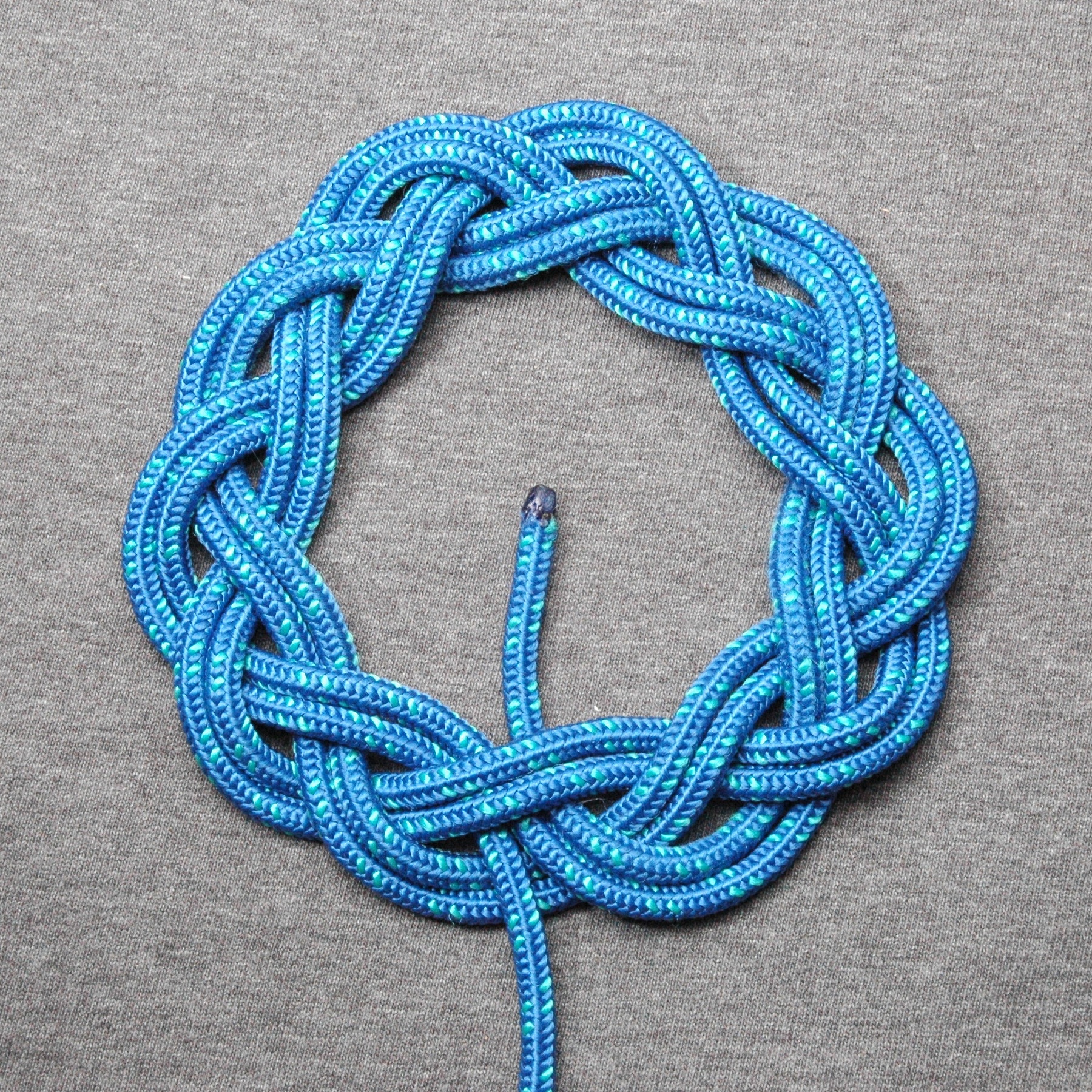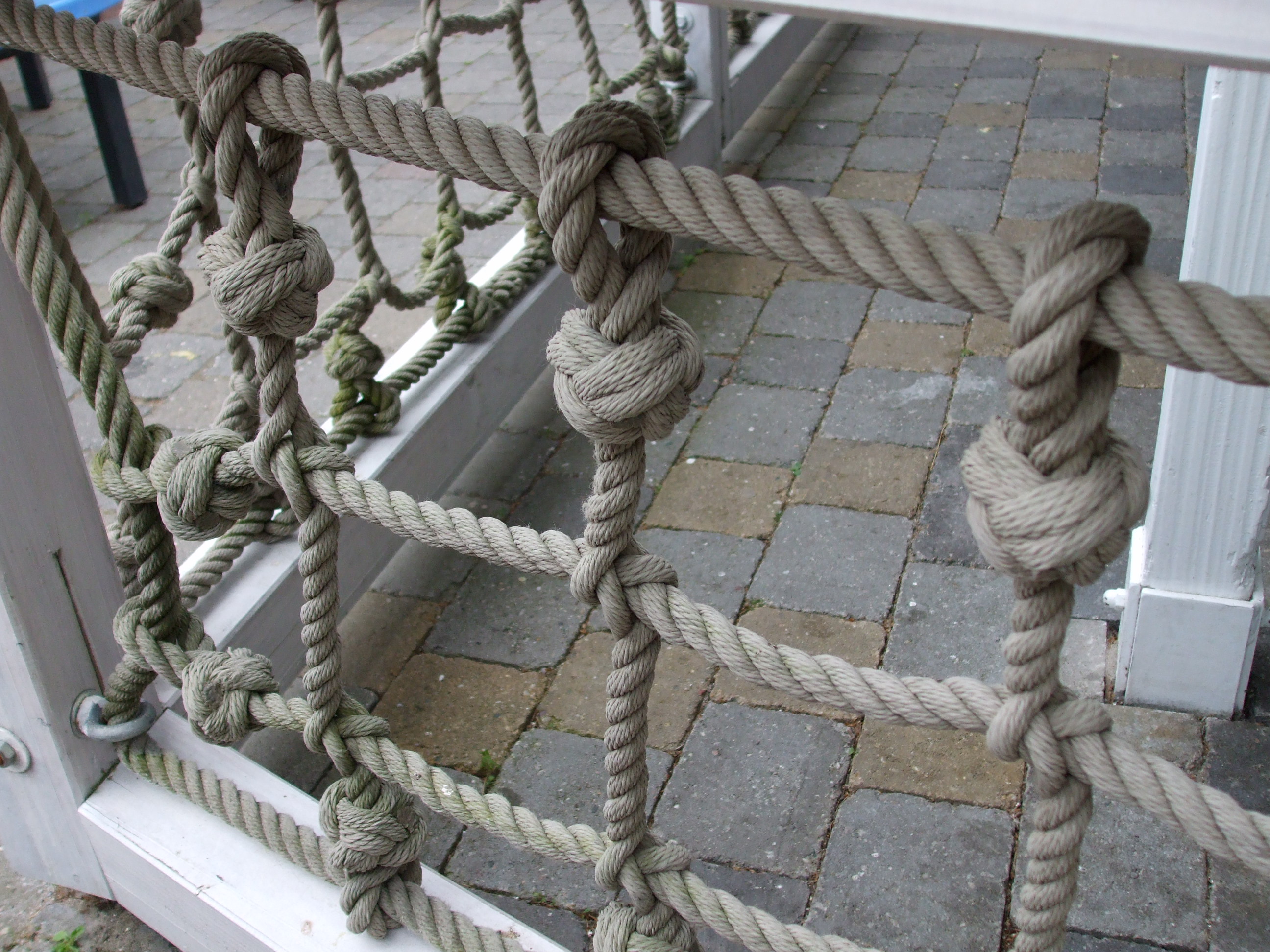Turk's Head Knot on:
[Wikipedia]
[Google]
[Amazon]
A Turk's head knot, sometimes known as a sailor's knot, is a decorative
 Different types of Turk's head knots are classified according to the number of leads and bights, as well as the method of construction. The number of bights is the number of crossings around the circumference of the cylinder. The number of leads refers to the number of strands around the circumference of the cylinder, before doubling, tripling, etc. Depending on the number of leads and bights, a Turk's head may be tied using a single strand or multiple strands. Mathematically, the number of strands is the
Different types of Turk's head knots are classified according to the number of leads and bights, as well as the method of construction. The number of bights is the number of crossings around the circumference of the cylinder. The number of leads refers to the number of strands around the circumference of the cylinder, before doubling, tripling, etc. Depending on the number of leads and bights, a Turk's head may be tied using a single strand or multiple strands. Mathematically, the number of strands is the  The number of bights determines the shape found at the center. Three bights create a triangular shape, while four create a square. A two lead, 3 bight Turk's head is a double
The number of bights determines the shape found at the center. Three bights create a triangular shape, while four create a square. A two lead, 3 bight Turk's head is a double
Shurdington (UK Scouting) Turks head Knot
{{Knots
knot
A knot is an intentional complication in cordage which may be practical or decorative, or both. Practical knots are classified by function, including hitches, bends, loop knots, and splices: a ''hitch'' fastens a rope to another object; a ' ...
with a variable number of interwoven strands forming a closed loop. The name refers to a general family of knots, not an individual knot. While this knot is typically made around a cylinder, it can also be formed into a flat, mat-like shape. Some variants can be arranged into a roughly spherical shape, akin to a monkey's fist
A monkey's fist or monkey paw is a type of knot, so named because it looks somewhat like a small bunched fist or paw. It is tied at the end of a rope to serve as a weight, making it easier to throw, and also as an ornamental knot. This type of ...
knot.
This knot is primarily used for tightening up underlying material to overlay as a tubular covering knot, prevent slipping, and add a decorative element. A notable practical use for the ''Turk's head'' is to mark the "king spoke" of a ship's wheel
A ship's wheel or boat's wheel is a device used aboard a water vessel to steer that vessel and control its course. Together with the rest of the steering mechanism, it forms part of the helm. It is connected to a mechanical, electric servo, or ...
(the spoke that is upright when the rudder
A rudder is a primary control surface used to steer a ship, boat, submarine, hovercraft, aircraft, or other vehicle that moves through a fluid medium (generally aircraft, air or watercraft, water). On an aircraft the rudder is used primarily to ...
is in a central position). The knot takes its name from its resemblance to a turban
A turban (from Persian دولبند, ''dulband''; via Middle French ''turbant'') is a type of headwear based on cloth winding. Featuring many variations, it is worn as customary headwear by people of various cultures. Communities with promin ...
( tr, sarık), though a turban is wound rather than interwoven.
Leads and bights
 Different types of Turk's head knots are classified according to the number of leads and bights, as well as the method of construction. The number of bights is the number of crossings around the circumference of the cylinder. The number of leads refers to the number of strands around the circumference of the cylinder, before doubling, tripling, etc. Depending on the number of leads and bights, a Turk's head may be tied using a single strand or multiple strands. Mathematically, the number of strands is the
Different types of Turk's head knots are classified according to the number of leads and bights, as well as the method of construction. The number of bights is the number of crossings around the circumference of the cylinder. The number of leads refers to the number of strands around the circumference of the cylinder, before doubling, tripling, etc. Depending on the number of leads and bights, a Turk's head may be tied using a single strand or multiple strands. Mathematically, the number of strands is the greatest common divisor
In mathematics, the greatest common divisor (GCD) of two or more integers, which are not all zero, is the largest positive integer that divides each of the integers. For two integers ''x'', ''y'', the greatest common divisor of ''x'' and ''y'' is ...
of the number of leads and the number of bights. The knot may be tied with a single strand if and only if
In logic and related fields such as mathematics and philosophy, "if and only if" (shortened as "iff") is a biconditional logical connective between statements, where either both statements are true or both are false.
The connective is bicondi ...
the two numbers are co-prime. For example, 3 lead × 5 bights (3×5), or 5 lead × 7 bights (5×7).
There are three general groupings of Turk's head knots:
# Narrow, where the number of leads is two or more less than the number of bights (3×5, or 3×7).
# Long or Wide, where the number of leads is two or more greater than the number of bights (5×3, or 16×7).
# Square, where there is a difference of one between leads and bights (7×8 or 8×7).
 The number of bights determines the shape found at the center. Three bights create a triangular shape, while four create a square. A two lead, 3 bight Turk's head is a double
The number of bights determines the shape found at the center. Three bights create a triangular shape, while four create a square. A two lead, 3 bight Turk's head is a double overhand knot
The overhand knot is one of the most fundamental knots, and it forms the basis of many others, including the simple noose, overhand loop, angler's loop, reef knot, fisherman's knot, Half hitch, and water knot. The overhand knot is a stopper, ...
.
A two lead, three bight Turk's head is also a trefoil knot
In knot theory, a branch of mathematics, the trefoil knot is the simplest example of a nontrivial knot. The trefoil can be obtained by joining together the two loose ends of a common overhand knot, resulting in a knotted loop. As the simplest ...
if the ends are joined together. (2,n) alternating torus knot
In knot theory, a torus knot is a special kind of knot that lies on the surface of an unknotted torus in R3. Similarly, a torus link is a link which lies on the surface of a torus in the same way. Each torus knot is specified by a pair of cop ...
s are (2,n) Turk's head knots.Bozhuyuk, M. E. (1993). ''Topics in Knot Theory'', p.3. . ((''p'',''q'') = ''q'' times around a circle in the interior of the torus, and ''p'' times around its axis of rotational symmetry.) Turk's head knots are easy to edit though hard to tie.
Uses in culture
TheWorld Organization of the Scout Movement
The World Organization of the Scout Movement (WOSM ) is the largest international Scouting organization. WOSM has 173 members. These members are recognized national Scout organizations, which collectively have around 43 million participants. WOSM ...
uses a variation of the Turk's head knot called a woggle
A woggle (or ''neckerchief slide'') is a device to fasten the neckerchief, or scarf, worn as part of the Scout or Girl Guides uniform, originated by a Scout in the 1920s.
Name origin
One story relating to the origin of the word 'woggle' is ...
to affix their neckerchief
A neckerchief (from ''neck'' (n.) + ''kerchief''), sometimes called a necker, kerchief or scarf, is a type of neckwear associated with those working or living outdoors, including farm labourers, cowboys and sailors. It is most commonly still see ...
s or scarfs and as a fire starting tool. The woggle
A woggle (or ''neckerchief slide'') is a device to fasten the neckerchief, or scarf, worn as part of the Scout or Girl Guides uniform, originated by a Scout in the 1920s.
Name origin
One story relating to the origin of the word 'woggle' is ...
is also used by some Scout Leader
A Scout leader or Scouter generally refers to the trained adult leader of a Scout unit. The terms used vary from country to country, over time, and with the type of unit.
Roles
There are many different roles a leader can fulfill depending on t ...
s who complete training courses to be award
An award, sometimes called a distinction, is something given to a recipient as a token of recognition of excellence in a certain field. When the token is a medal, ribbon or other item designed for wearing, it is known as a decoration.
An awar ...
ed the Wood Badge
Wood Badge is a Scouting leadership programme and the related award for adult leaders in the programmes of Scout associations throughout the world. Wood Badge courses aim to make Scouters better leaders by teaching advanced leadership skills ...
insignia. It is an official part of the uniform.
See also
*List of knots
This list of knots includes many alternative names for common knots and lashings. Knot names have evolved over time, and there are many conflicting or confusing naming issues. The overhand knot, for example, is also known as the thumb knot. The ...
References
External links
*Shurdington (UK Scouting) Turks head Knot
{{Knots